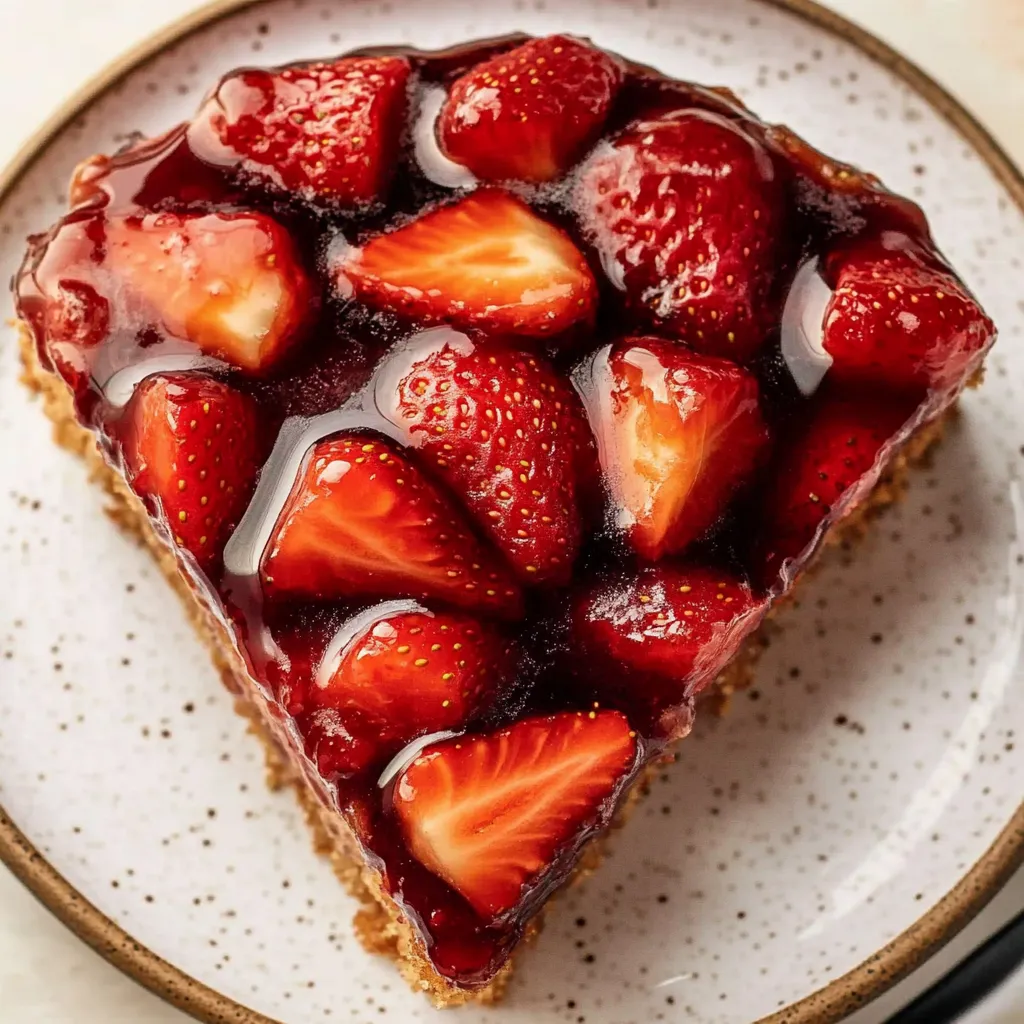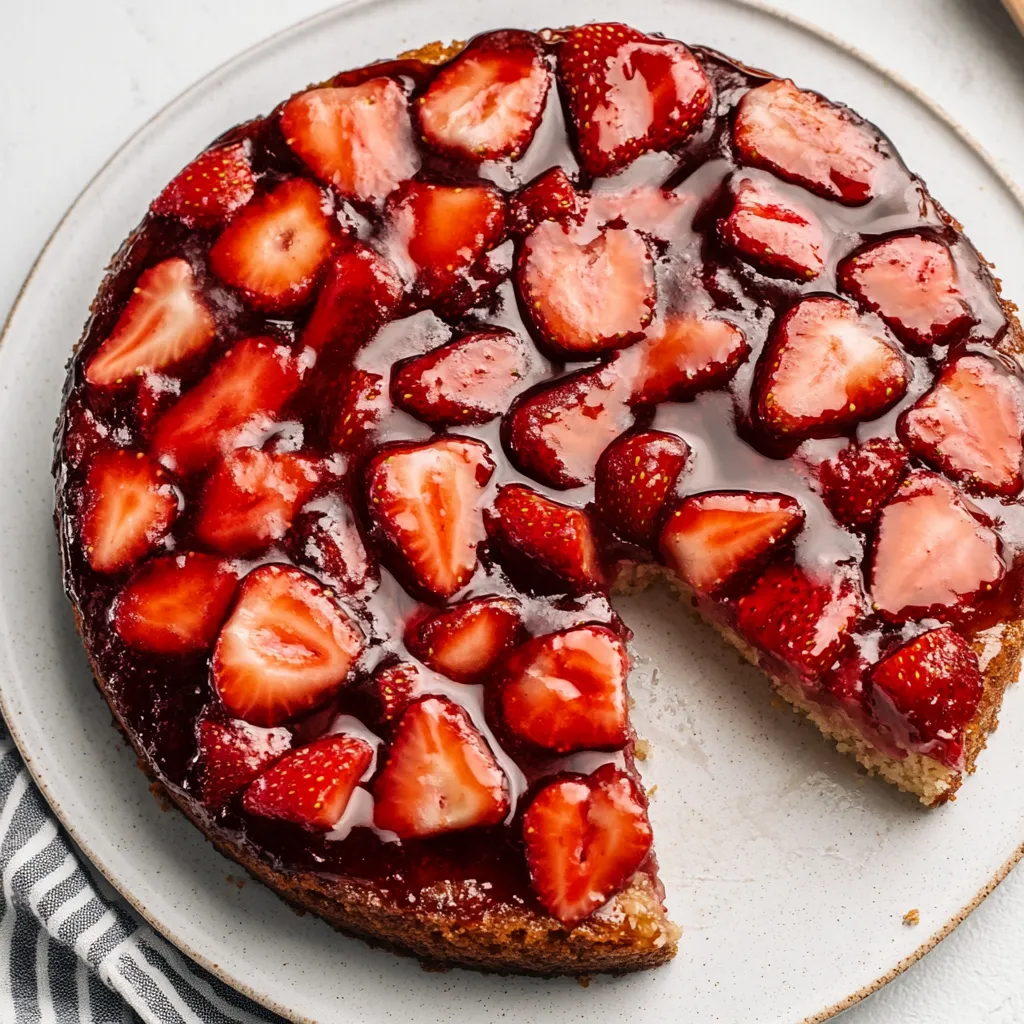 Pin it
Pin it
This vibrant strawberry upside down cake transforms fresh, juicy berries into a caramelized topping that sits beautifully over a tender, fluffy vanilla cake base. Made completely plant-based and gluten-free, it delivers all the comfort and satisfaction of traditional cake while being wholesome enough to enjoy any time of day. The magic happens when those gorgeous strawberries cook down into an almost jammy compote that soaks slightly into the cake, creating layers of flavor that make each bite absolutely irresistible.
I discovered this recipe during strawberry season when I had way too many berries that were getting soft and needed to be used quickly. Traditional upside-down cakes usually call for pineapple, but I thought strawberries deserved their moment to shine in this classic format. The first time I flipped it out of the pan and saw those beautiful caramelized berries glistening on top, I knew I'd found something special. My family now requests this every time strawberries go on sale, and I love that it's wholesome enough that I don't feel guilty serving it for weekend breakfast alongside coffee.
Ingredients
- Fresh strawberries (3 cups, hulled and halved) - Choose berries that are ripe but still firm, as they'll soften beautifully during baking without turning to mush
- Full-fat coconut milk (1 can, 14 oz) - The thick, creamy part creates richness in both the cake and the strawberry topping without any dairy
- Coconut sugar (3/4 cup total) - This unrefined sugar adds subtle caramel notes that complement the strawberries perfectly while keeping the cake naturally sweetened
- Pure vanilla extract (2 teaspoons) - Use real vanilla for the best flavor depth that enhances both the fruit and cake components
- Oat flour (2 cups) - Creates a hearty, satisfying cake base with more fiber and nutrients than regular flour while staying completely gluten-free
- Tapioca starch (1/4 cup) - This helps bind the cake together and gives it that perfect tender crumb while also thickening the strawberry layer
- Baking powder (2 teaspoons) - Make sure yours is fresh and aluminum-free for the best rise and clean flavor
- Sea salt (1/2 teaspoon) - Enhances all the other flavors and balances the natural sweetness beautifully
- Apple cider vinegar (1 tablespoon) - Creates a chemical reaction with the baking powder for extra lift and helps tenderize the gluten-free flour
Instructions
- Preheat your oven to 375°F and prepare your cake pan.
- Grease a 9-inch round cake pan thoroughly with coconut oil or vegan butter, then line the bottom with parchment paper for easy release. This extra step is crucial because upside-down cakes need to come out of the pan cleanly to show off that beautiful fruit topping.
- Create the stunning strawberry layer first.
- In a medium bowl, gently combine the halved strawberries with 1/4 cup coconut sugar, 1/4 cup coconut milk, 1 tablespoon tapioca starch, and 1 teaspoon vanilla extract. Toss everything together until the strawberries are well-coated and the mixture looks glossy and slightly thickened.
- Arrange the strawberry mixture in your prepared pan.
- Spread the seasoned strawberries evenly across the bottom of your greased cake pan, arranging them cut-side down for the most beautiful presentation when flipped. The mixture will seem a bit liquidy, but this is perfect - it will cook down into a gorgeous compote during baking.
- Prepare the dry ingredients for the cake base.
- In a large mixing bowl, whisk together the oat flour, remaining 1/2 cup coconut sugar, baking powder, and sea salt until everything is evenly distributed. This ensures your leavening agents are properly dispersed for even rising.
- Combine the wet ingredients thoroughly.
- In a separate bowl, whisk together the remaining coconut milk, vanilla extract, and apple cider vinegar until smooth and well combined. The vinegar will react slightly with the coconut milk, which is exactly what we want for tender cake texture.
- Create the cake batter with minimal mixing.
- Pour the wet ingredients into the dry ingredients and stir gently just until no dry flour streaks remain. Don't overmix - a few small lumps are fine and actually preferred to keep the cake tender rather than tough and dense.
- Layer the batter over the strawberries carefully.
- Pour the cake batter evenly over the strawberry layer in the pan, using a spatula to spread it gently to the edges. Try not to disturb the strawberry arrangement underneath, as this will be your beautiful top layer when flipped.
- Bake until golden and perfectly set.
- Bake for 35-40 minutes, until the top is golden brown and springs back lightly when touched, and a toothpick inserted into the cake portion (not the fruit) comes out clean or with just a few moist crumbs.
- Cool briefly before the dramatic flip.
- Let the cake cool in the pan for exactly 10 minutes - not longer, or it might stick. Run a knife around the edges to loosen, then place a serving plate over the pan and quickly but confidently flip the whole thing over. Let it sit for a minute before lifting the pan to reveal your masterpiece.
 Pin it
Pin it
Understanding Gluten-Free Cake Texture
When working with gluten-free flours like oat flour, the texture will be different from traditional wheat-based cakes, and that's completely normal and delicious in its own right. Oat flour creates a heartier, more substantial crumb that actually works perfectly for upside-down cakes because it can support the weight of the fruit topping without becoming soggy or collapsing.
The tapioca starch plays a crucial role in binding everything together since we don't have gluten to provide structure. It also helps create that tender, slightly chewy texture that makes each bite satisfying. Don't expect this cake to be as light and airy as traditional sponge cake - instead, it has a lovely dense, moist quality that pairs beautifully with the juicy strawberry topping.
The Magic of Natural Sweeteners
Coconut sugar brings so much more to this cake than just sweetness - it has subtle caramel and molasses notes that enhance the natural strawberry flavors without overpowering them. Unlike refined white sugar, coconut sugar retains some minerals and has a lower glycemic index, making it a more wholesome choice for regular enjoyment.
The natural sugars in the ripe strawberries also contribute significantly to the overall sweetness, especially as they concentrate during baking. This is why choosing properly ripe berries is so important - they should smell fragrant and give slightly when pressed. Underripe berries won't provide enough natural sweetness and might make the cake taste tart rather than perfectly balanced.
Storage and Serving Suggestions
This cake is absolutely at its best served the same day it's made, when the contrast between the tender cake and the jammy strawberry topping is most pronounced. You can serve it warm from the oven, which makes the strawberries taste almost like a compote and pairs beautifully with vanilla ice cream or whipped coconut cream.
If you need to store leftovers, keep them covered in the refrigerator for up to two days, but know that the cake will absorb some moisture from the fruit topping and become softer. Some people actually prefer this texture, as it becomes almost like a cross between cake and bread pudding. For the best appearance, always store it fruit-side up to maintain that beautiful presentation.
Seasonal Variations and Adaptations
While strawberries are absolutely perfect in this recipe, the basic technique works beautifully with other soft fruits throughout the year. Try it with fresh peaches or nectarines in late summer, or a mix of berries when they're at their peak. Pears work wonderfully in fall, especially when you add a pinch of cinnamon to the fruit mixture.
You can also play with the cake base by adding lemon zest for brightness, or a touch of almond extract for depth. During winter months when fresh berries are expensive, frozen strawberries work well too - just thaw them completely and drain off excess liquid before using. The key is adjusting the cooking time slightly since frozen fruit releases more moisture.
Creating the Perfect Flip
The moment of flipping an upside-down cake is always a little nerve-wracking, but with the right technique, it works beautifully every time. The key is timing - too soon and the cake might fall apart, too late and it might stick to the pan. That 10-minute cooling window is crucial for allowing the cake to set just enough while the fruit topping is still warm and releases easily.
Make sure your serving plate is larger than your cake pan to catch any fruit that might slide off during flipping. Work confidently and quickly when you flip - hesitation can lead to uneven results. If a few strawberry pieces stick to the pan, just gently place them back on top of the cake where they belong.
I love how this recipe proves that wholesome ingredients can create something just as indulgent and satisfying as traditional desserts. When I serve this to guests, they're always surprised to learn it's vegan and gluten-free because the flavors are so rich and the texture so satisfying. My kids have been known to request it for birthday celebrations instead of traditional cake, and I never mind saying yes because they're getting real fruit and whole grain goodness along with their sweet treat.
This cake represents everything I love about seasonal baking - taking advantage of beautiful fresh ingredients at their peak and transforming them into something that brings people together around the table. Every time strawberry season arrives, I get excited knowing I'll be making this cake multiple times, and it never gets old. There's something so satisfying about creating a dessert that looks impressive but uses simple, wholesome ingredients that make you feel good about what you're serving to the people you care about.
Frequently Asked Questions
- → Can I use frozen strawberries instead of fresh?
- Fresh strawberries work best since frozen ones release too much liquid and can make the cake soggy.
- → What can I substitute for coconut sugar?
- You can use brown sugar or regular white sugar in the same amount as a substitute for coconut sugar.
- → How long does this cake stay fresh?
- This cake is best eaten the same day it's made. It will become soggy if stored overnight.
- → Can I make this cake without tapioca starch?
- You can substitute cornstarch for tapioca starch, but avoid using arrowroot powder as it may make the sauce lumpy.
- → Do I need to grind my own oat flour?
- Yes, grinding rolled oats into flour gives the best texture. You can use a food processor or high-speed blender.
